Saudi Arabia – Medina Province (Yanbu) Dec 7, 2021
MEDINA PROVINCE
The Al Ula area is a fantastic landscape of eroded sandstone: buttes, mesas, chimneys, pinnacles, and a few arches (the most famous is Elephant rock). It reminds me of the Needles District of Canyonlands NP in Utah.
AL-RIJR ARCHAEOLOGICAL SITE World Heritage Sites 2008. Mada’in Saleh (‘Cities of Salih’) dates from the Nabatean kingdom (1st century AD), the kingdom’s southernmost and largest settlement after Petra, its capital. Traces of Lihyanite and Roman occupation before and after the Nabatean rule, respectively, can also be found.
The site has earned a reputation as a cursed place. The well-preserved remains of the 131 rock-cut monumental tombs, with their elaborately ornamented façades, of the Nabatean kingdom are the highlight.
Location: 20 km (12 mi) north of the town of Al-`Ula, 400 km (250 mi) north-west of Medina, and 500 km (310 mi) south-east of Petra, Jordan. The setting is notable for its desert landscape, marked by sandstone outcrops of various sizes and heights.
Numerous rock writings and pictures date between the sixth century BC and the fourth century AD and are labeled as being Thamudic. The settlement of the Lihyans became a center of commerce, with goods from the east, north, and south converging in the locality.
Nabatean Era. The extensive settlement of the site took place during the 1st century AD, when the Nabatean made Mada’in Salih the kingdom’s second capital, after Petra in the north. The place enjoyed a huge urbanization movement, turning it into a city. Characteristic of Nabatean rock-cut architecture, the geology of Mada’in Salih provided the perfect medium for the carving of monumental and settlements, with Nabatean scripts inscribed on their façades. The Nabateans also developed oasis agriculture—digging wells and rainwater tanks in the rock and carving places of worship in the sandstone outcrops. Similar structures were featured in other Nabatean settlements, ranging from southern Syria (region) to the north, going south to the Negev, and down to the immediate area of the Hejaz. The most prominent and the largest of these is Petra.
At the crossroad of commerce, the Nabatean kingdom flourished, holding a monopoly for the trade of incense, myrrh, and spices. Situated on the overland caravan route and connected to the Red Sea port of Egra Kome, Mada’in Salih, then referred to as Hegra among the Nabateans, reached its peak as the major staging post on the main north-south trade route.
Roman era. In 106 AD, the Nabatean kingdom was annexed by the contemporary Roman Empire. Trading shifted from the overland north-south axis on the Arabian Peninsula to the maritime route through the Red Sea. Thus, Hegra as a center of trade began to decline, leading to its abandonment. It had lost all of its urban functions beginning in the late Antiquity (mainly due to the process of desertification).
It was only sporadically mentioned by travelers and pilgrims making their way to Mecca in the succeeding centuries. Ottoman era. Between 1744-57, a fort and cistern/well served as a one-day stop for Hajj pilgrims.
The Nabatean site of Hegra was built around a residential zone and its oasis during the 1st century CE. The sandstone outcrops were carved out to build the necropolis. A total of four necropolis areas have survived, which featured 131 monumental rock-cut tombs spread out over 13.4 km (8.3 mi), many with inscribed Nabatean epigraphs on their façades.
2000 non-monumental burial sites, many military indicate the site might once have been a Nabatean military base. In contrast to the elaborate exteriors, the interiors of the rock-cut structures are severe and plain.
A religious area, known as “Jabal Ithlib,” is located to the north-east of the site. A narrow corridor, 40 metres (131 ft) long between the high rocks and reminiscent of the Siq in Petra, leads to the hall of the Diwan, a Muslim’s council-chamber or law-court.
The dry climate, the lack of resettlement after the site was abandoned, and local beliefs led to the extraordinary state of preservation of Al-Hijr, providing an extensive picture of the Nabatean lifestyle. Thought to mark the southern extent of the Nabatean kingdom, Al-Hijr’s oasis agriculture and extant wells exhibit the necessary adaptations made by the Nabateans in the given environment. The location of the site at the crossroads of trade, as well as the various languages, scripts and artistic styles reflected in the façades of its monumental tombs further set it apart from other archaeological sites. It has duly earned the nickname “The Capital of Monuments” among Saudi Arabia’s 4,000 archaeological sites.
4 hours drive from Medina, 7 hours from Jeddah. Often seen as a tour along with Elephant Rock, the ghost city, and the Hejaz Railway station
I arrived at the gates to be informed that I needed a ticket available at Winter Park, about 27 km away in Al Ala. I arrived late but was able to buy one (85 SAR) for the first tour in the morning at 9. Meet in the lot to get the bus that leaves at 8:30 to drive the half-hour to the site.
Hegra is much larger than the fenced-in site of 52 hectares covering over 100 square km. There are 133 known tombs in the area. Prospective owners purchased a piece of rock from the king and hired carvers, usually at most 10. Starting from the top-down using only a hammer and chisel the rough cuts were made, then the fine cutting of all the details. Basalt was used to sand the surfaces to a fine coat. It took from 3-10 months to finish the job. The lower social classes were buried in pit graves.
Some tombs have inscriptions telling who commissioned the tomb. They are adorned with eagles (the animist god of the Nabateans), sphinxes, masks, urns, rosettes, and one with a Medusa and snake.
Al Fareed (“the unique”) is the best of the tombs, the largest, the only one with four columns, the only one that is separate and the most famous. The bottom remains unfinished. This was built by the son of Juga, a general in the Nabatean army. He was killed in Petra and not buried here.
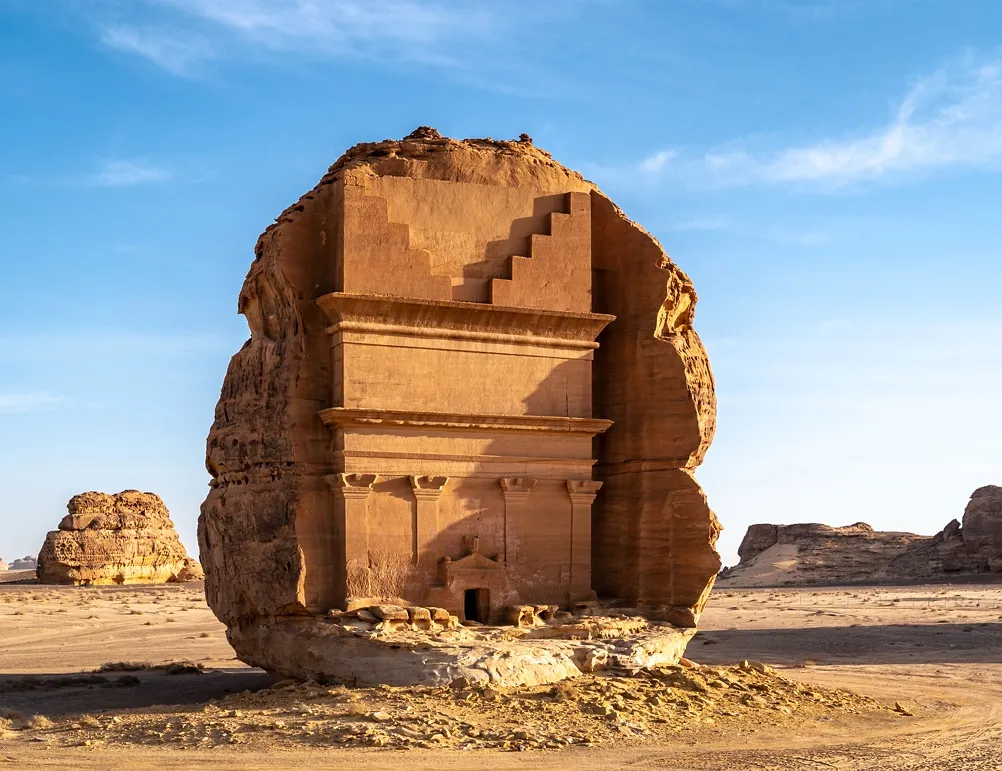
Jabal Al Benat (“Girl’s Mountain). This large rock has 31 tombs cut around its perimeter, 18-20 of which were for women.


Holy area. With a narrow passage, with some small carved niches, it reminds one of Petra. There is only one significant structure here, a large room with a wide bench on 3 sides used as a meeting room
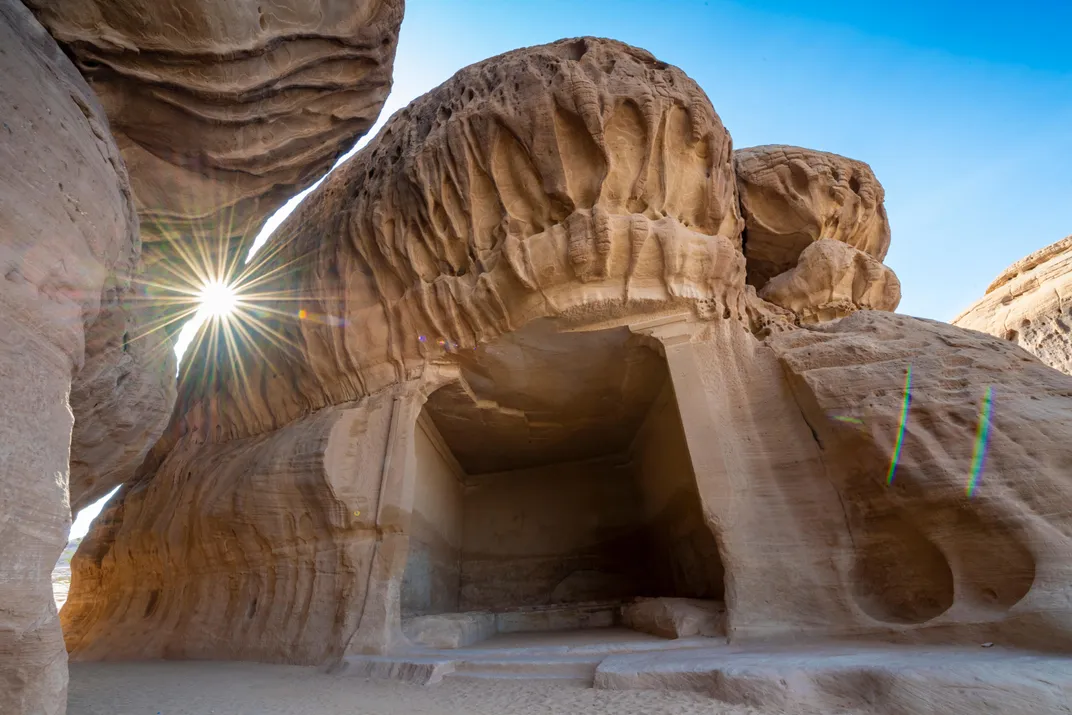
Rock Art in the Hail Region of Saudi Arabia World Heritage Sites. Jabal Al-Manjor and Jabal Raat at Shuwaymis. 250 km south of Hail. Forms the rocky escarpment of a wadi now covered in sand. 10,000 year testimony of a society that vanished, leaving behind a detailed record of its existence. In a valley with flowing water.
Shuwaimis Cave. One of the longest caves in Saudi Arabia, stretching a spectacular length of 530 meters, is Shuwaimis, a cave located in the southwest of the Kingdom’s Hail region. Shuwaimis Cave comes in third in length after Habashi Cave in Taif (581 meters) and Um Jarsan Cave in Khaibar (about 1,500 meters),
Darb Zubayda (Pilgrim Road from Kufa to Makkah) Tentative WHS (08/04/2015)
Hejaz. On the Red Sea coast, site of Mecca, Medina, Jeddah and the home of trade and commerce.
Egyptian Hajj Road. Tentative WHS (08/04/2015). One of the important pilgrimage routes in Islamic history, linking Egypt to Makkah and Medina. For pilgrims coming from Morocco, Libya, Tunisia, Egypt, Sudan, Central Africa,, Andalusia and Sicily who meet in Egypt, then travel through Sinai to Aqaba then continue south on either of two trails: an inland trail moving to Medina passing Shaghab, Beda, the valley of the villages or the second route on the coast. Had constructed pools, canals, wells, paved obstacles, built barricades, bridges, castles, forts and mosques, numerous Islamic inscriptions and commemorative writings, engraved by pilgrims.
Hejaz Railway. Tentative WHS (08/04/2015). A 1,300km-long, narrow-gauge railway that ran from Damascus to Medina, through the Hejaz region of Saudi Arabia, with a branch line to Haifa on the Mediterranean Sea. Part of the Ottoman railway network, the original goal was to extend the line to Mecca, but construction was interrupted by WW1 and it reached no further than Medina, 400 kilometres (250 mi) short of Mecca.
Its main purpose was to connect Constantinople and Hejaz in Arabia, the site of the holiest shrines of Islam and to improve the economic and political integration of the distant Arabian provinces into the Ottoman state, and to facilitate the transportation of military forces.
Syrian Hajj Road. (08/04/2015). The oldest Road used by Muslim pilgrim convoys after the Makkah /Madinah road, at 1307kms, it connects Damascus to Madinah, passing That Al- Hajj, Tabuk, Al-Akhdhar, Al-Mu’azam, Al-Aqraa, Al-Hijr, and Al-Ula. Road then links with the Egyptian Hajj Road after Medina.
MEDINA. (Madinah) – The second holiest city of Islam and the site of the Prophet’s Mosque, the Prophet Muhammad’s final resting place. The Prophet built the first state or government in this city. Islamic Political Model i.e (Caliphate or Khilafat), Islamic Economic Model (interest-free, commodity currency i.e. gold and silver coins-based system, an alternative to capitalism and socialism) were implemented for the first time here.
Non-Muslims are strictly prohibited from entering the Prophet’s Mosque. The penalty is deportation from the country. Documentation will be checked upon entry and anyone not showing proof of being Muslim will be denied entry. Central Medina used to be closed off to non-Muslims however many current reports it is accessible. This is not true. I parked in the big lot and joined thousands of others at the 5 pm prayer. My app was checked and ust walked in. looked around and left. No one said a word to me.
Most of the things to be done or seen are around this grand mosque which is at the city centre. Adjacent to the mosque is Jannatul Baqi, a huge graveyard, where most family members and companions of the Prophet are buried. Other things to be seen, a little away from the city, are the plains and mountain of Uhud where the battle took place. There is also the burial ground of the 70 martyrs of this battle including the Prophet’s uncle Hamza who is considered one of the greatest martyrs of all time.
Medina is famous for palm plantations and the most popular date is “Ajwah” and “Rothana”
Dar Al Madinah Museum. This museum has hundreds of scale model constructions of everything around Medina. Descriptions are long and only in Arabic. I could have gotten a guide by didn’t, so not very interesting. 25 SAR
AL-MASID AN-NABAWI (The Prophetic Mosque’) is a mosque built by the Islamic prophet Muhammad in Medina. It was the second mosque built by Muhammad in Medina, after Masjid Quba’a, and is the second largest mosque and the second holiest site in Islam, both titles ranking after the Masjid al-Haram in Mecca. It is generally open regardless of date or time and has only been closed to visitors once in modern times, as Ramadan approached during the 2020 COVID-19 pandemic.
Muhammad shared in the construction of the mosque. Originally an open-air building, the mosque served as a community center, a court of law, and a religious school. There was a raised platform or pulpit (minbar) for the people who taught the Quran and for Muhammad to give the Friday sermon (khutbah). Subsequent Islamic rulers greatly expanded and decorated the mosque, naming its walls, doors and minarets after themselves and their forefathers.
After an expansion during the reign of the Umayyad caliph Al-Walid I, it now incorporates the final resting place of Muhammad and the first two Rashidun caliphs Abu Bakr and Umar. One of the most notable features of the site is the Green Dome in the southeast corner of the mosque, originally Aisha’s house, where the tomb of Muhammad is located. Many pilgrims who perform the Hajj also go to Madinah to visit (Ziyarah) the Green Dome. In 1909, under the reign of Ottoman Sultan Abdul Hamid II, it became the first place in the Arabian Peninsula to be provided with electrical lights. The mosque is located at the heart of Madinah and is a major pilgrimage site.
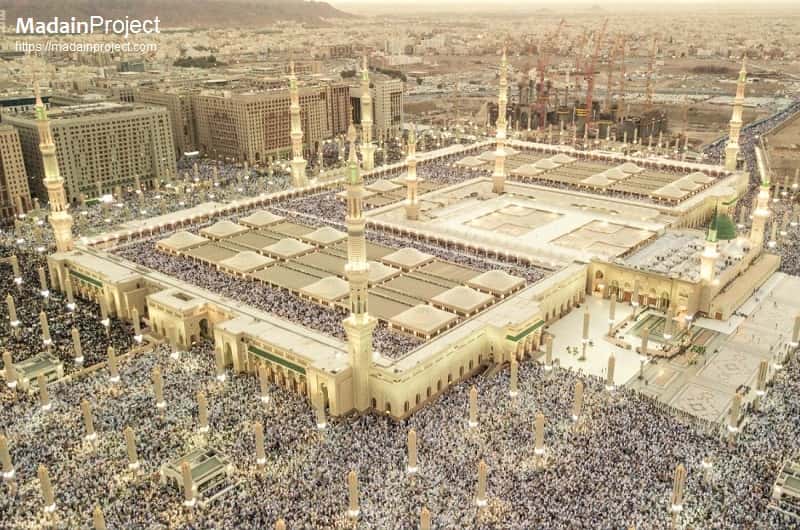
Architecture. The modern-day Masjid an-Nabawi is two stories tall. The Ottoman prayer hall, the oldest part, has a flat paved roof topped with 27 sliding domes on square bases. Holes pierced into the base of each dome illuminate the interior when the domes are closed. The sliding roof is closed during the afternoon prayer to protect the visitors. When the domes slide out on metal tracks to shade areas of the roof, they create light wells for the prayer hall. At these times, the courtyard of the Ottoman mosque is also shaded with umbrellas affixed to freestanding columns. The paved area around the mosque is also used for prayer, equipped with umbrella tents.
Green Dome. The chamber adjacent to the Rawdah holds the tombs of Muhammad and two of his companions, fathers-in-laws, and caliphs, Abu Bakr and Umar ibn al-Khattab. It was constructed in 1817 CE.
Green Dome. The Green Dome is a green-coloured dome built above al-Masjid an-Nabawi, the tomb of the prophet Muhammad and early Muslim Caliphs, Abu Bakr and Umar. The dome is located in the southeast corner of the Mosque. The structure dates back to 1279 CE, when an unpainted wooden cupola was built over the tomb. The dome was first painted green in 1837, and hence became known as the Green Dome.
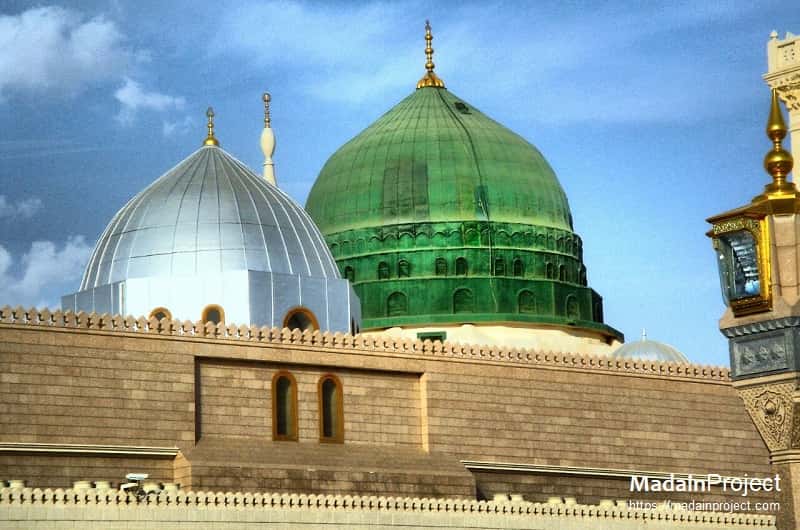
![]()
![]()
![]() Mihrab. There are two mihrabs.
Mihrab. There are two mihrabs.
Minbar. In 1590, the present Ottoman marble minbar was built. As of 2013, the Ottoman minbar is still used in the mosque.
Minarets. After the renovation project of 1994, there were ten minarets which were 104 metres (341 ft) high. The minarets’ upper, bottom, and middle portions are cylindrical, octagonal, and square-shaped respectively.
Quba Mosque is located on the outskirts of Medina. Initially, the mosque was built 6 kilometres from Medina in the village of Quba, before Medina expanded to include this village. Depending on whether the Mosque of the Companions in the Eritrean city of Massawa is older or not, it may be the first mosque in the world that dates to the lifetime of the Islamic prophet Muhammad in the 7th century CE. According to records, its first stones were positioned by Muhammad as soon as he arrived on his emigration from the city of Mecca to Medina, and the mosque was completed by his companions. Muhammad spent 14 days in this mosque praying qaṣr (Arabic: قَـصْـر, a short prayer) while waiting for Ali to arrive in Medina, after the latter stayed behind in Mecca to safeguard Muhammad’s life and safe escape by sleeping in Muhammad’s bed in his place, an event referred to in the Quran, sura al Baqara verse 207. Also going along with traditional saying, this mosque is said to be where the first Friday prayer was held, led by Muhammad.
The old mosque was torn down and replaced with a new one in 1984 with a rectangular prayer hall raised on a second-story platform and with 7 main entrances, 4 parallel minarets, and the 56 mini domes that surround the perimeter of the mosque. The courtyard of this mosque is composed of black, red, and white marble. And majority of the structure and interior structures such as the minbar and mihrab are all composed of white marble. Originally, there was one minaret, the new renovations included the addition of the other three minarets, they rest on square bases, have octagonal shafts which take on a circular shape as they reach the top.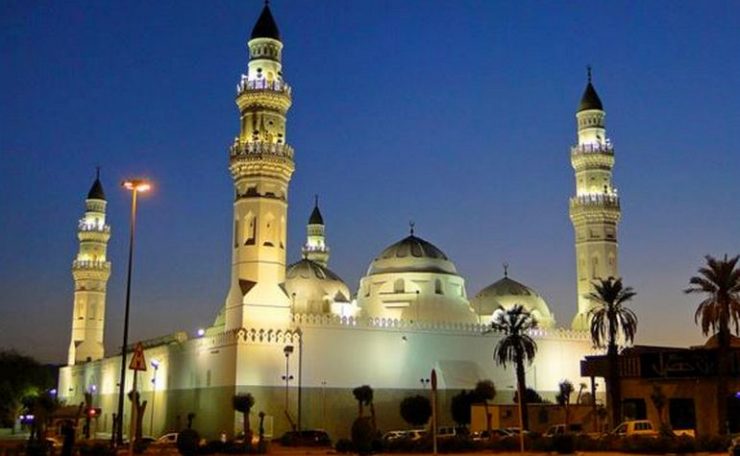
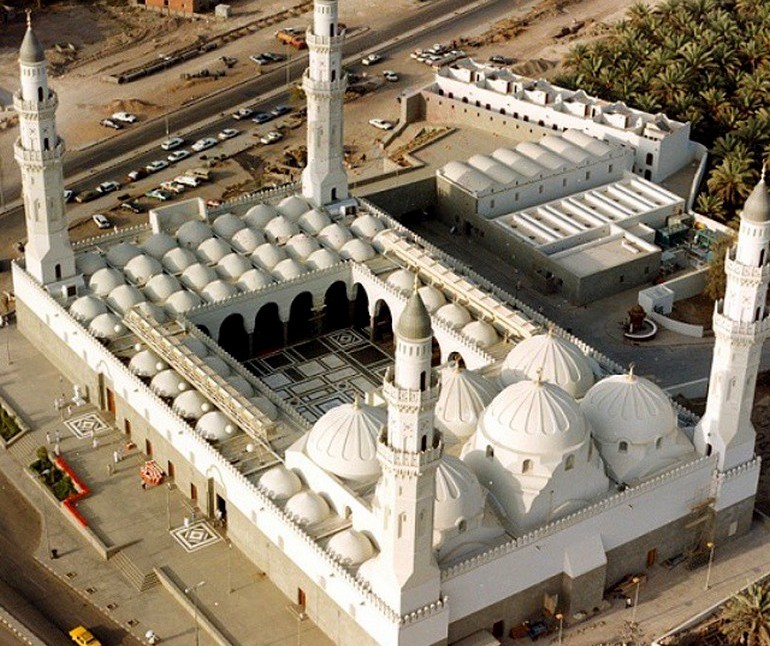 Old Bazaar. This was confusing to find as it is mostly a street lined with shops.
Old Bazaar. This was confusing to find as it is mostly a street lined with shops.
Al Hejaz Railway Museum. Opened in 2006. it is on the grounds of the restored[3] historic Ottoman railway station including a stretch of the historic track and a train shed. There are several engines and pieces of rolling stock on display, some from other places along the historic Hejaz railway line. 
I then drove to Jeddah to return my rental car. It must have taken an hour of driving around to find the New terminal. I was informed that I had over 4500 SAR of speeding tickets and I had to pay for them plus 20 SAR for the missing wheel cover.
Total miles were driven in Saudi Arabia – about 6600 over 10 days.
I then took a taxi to my hotel and left there at the latest check-out time of 2 pm to return to the airport for my 02:55 flight on Dec 9 to Karachi Pakistan.
